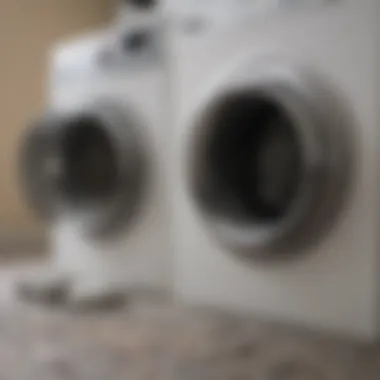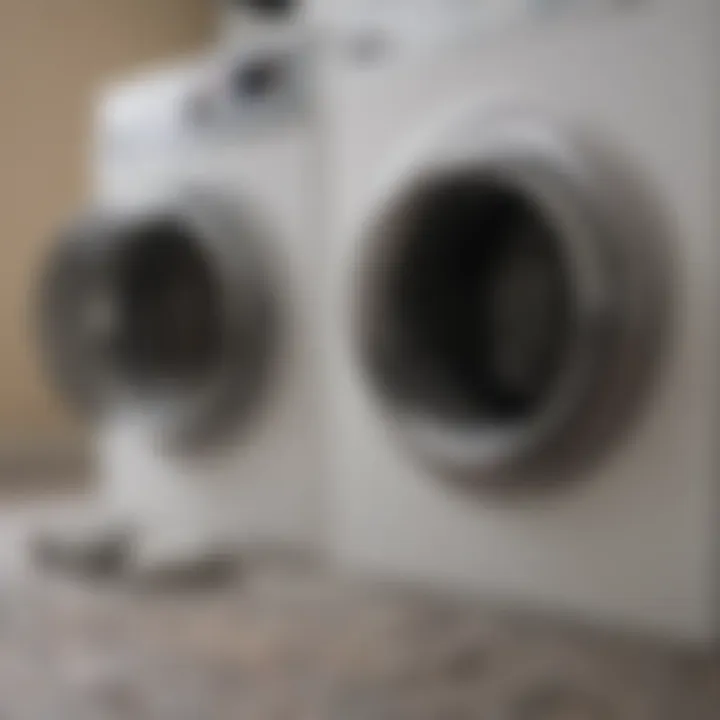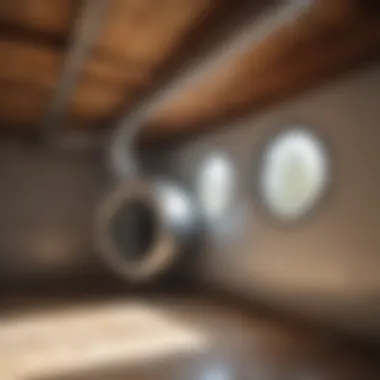Enhancing Dryer Efficiency: The Vital Role of Duct Cleaning


Intro
In households, dryers are indispensable appliances that serve a vital function. They simplify the process of drying laundry, saving time for many families. However, with great convenience comes the responsibility of maintenance. A key aspect of this maintenance is duct cleaning, which plays a significant role in the overall functioning of dryer ventilation systems. Poorly maintained ducts can lead to inefficiencies, safety hazards, and reduced lifespan of the dryer.
This article aims to dissect the nuances of duct cleaning for dryer ventilation. It will cover various topics, including the process of maintaining dryer ducts, the potential problems caused by neglect, and the substantial benefits that come with regular cleaning.
Understanding these aspects is essential not only for the operational efficiency of dryers but also for ensuring a safe and comfortable home environment.
Overview of Dryer Duct Systems
Understanding dryer duct systems is fundamental for maintaining appliances effectively. These ducts serve a critical role in venting moisture and heat produced during the drying process. Recognizing how these systems operate can enhance both efficiency and safety, preventing potential hazards such as fires or water damage.
Understanding Dryer Ducts
Dryer ducts are tubes that transport air from the dryer to the exterior of a home. They come in various materials, each with its own set of characteristics that can affect performance. A comprehensive understanding helps homeowners make informed decisions regarding installation, maintenance, and cleaning.
Types of Dryer Vent Ducts
Different types of dryer vent ducts exist, and each has particular benefits and drawbacks. Knowing these can help in determining the right choice based on individual needs and circumstances.
Rigid metal ducts
Rigid metal ducts are favored for their durability and resistance to deformation. They are often made from galvanized steel or aluminum and offer a smooth interior surface, allowing for optimal airflow. One of the key characteristics of rigid metal ducts is their long lifespan, which contributes significantly to an effective ventilation system. This type is beneficial due to its ability to minimize lint buildup, reducing fire risks and increasing drying efficiency. However, they can be challenging to install in tight spaces.
Flexible ducts
Flexible ducts provide versatility in installation. They are made from plastic or metal, allowing for easy maneuverability. A primary characteristic of flexible ducts is their lightweight construction, which makes them easier to work with than rigid options. Their design can accommodate various angles, making them useful in specific layouts. However, the unique feature of flexible ducts is that they can trap lint more easily because of their corrugated surfaces, which may require more frequent cleaning to mitigate fire hazards.
Foil ducts
Foil ducts are typically made of a lightweight aluminum material. They are designed to be flexible yet provide a smooth airflow path. The key characteristic of foil ducts is their resistance to high temperatures, which can be an asset in dryer systems. A significant advantage is that they are less expensive than rigid options and can be easily adapted to fit within tight spaces. Nonetheless, they are not as durable as rigid metal ducts, which might limit their longevity in more demanding environments.
In summary, the selection of dryer duct materials can significantly influence the performance and safety of the dryer system. Homeowners should weigh the advantages and disadvantages of each type to ensure optimal results.
The Functionality of Dryer Cleaning
The functionality of dryer cleaning must be understood in the context of its impact on efficiency and safety. Regular maintenance of dryer ducts includes removing lint and other debris that prevents proper airflow. Inefficient airflow can lead to longer drying times and increased energy consumption. When air does not flow freely, appliances strain to perform their jobs, ultimately leading to potential failures. The importance of an effective cleaning schedule cannot be overstated.
How Dryer Vents Work
Dryer vents are essential systems that guide hot air and moisture from the dryer to the outside of the building. The combustion and moisture of fabrics require this ventilation for safe and effective operation. A dryer vent typically comprises ducting that connects the dryer to an exterior vent outlet. Through this duct, the dryer exhaust moves outside, preventing the accumulation of moisture and lint within the system. Unimpeded airflow is crucial, as any blockage can lead to hazardous situations, including negative pressures that draw air back into the dryer rather than pushing it outside.
The Importance of Airflow
Airflow is not just a consideration; it is the driving force behind dryer performance. Each time a dryer operates, it generates hot air to evaporate moisture from wet clothes. If the airflow is restricted, the dryer must work harder to achieve the same drying results. The following points highlight the vital role airflow plays in dryer ventilation:
- Efficiency Loss: Blocked vents mean longer drying cycles. This results in wasted energy and increased utility bills.
- Fire Risks: Lint buildup in ducts can ignite, causing house fires. Regular cleaning greatly reduces these hazards.
- Appliance Wear: A dryer working harder than needed experiences more stress. This can shorten its lifespan.
In summary, understanding the functionality of dryer cleaning is essential for maintaining an effective and safe drying system. By ensuring that airflow is optimal, homeowners can ensure that their dryers operate smoothly while reducing risks associated with fire and appliance failure.
Reasons for Duct Cleaning
Duct cleaning is essential for maintaining the efficiency and safety of dryer ventilation systems. Regular maintenance helps prevent many issues that could arise from neglect. This section will dive into specific reasons for duct cleaning, emphasizing its crucial benefits, including fire safety, efficiency in drying, and extending the lifespan of appliances.
Preventing Fire Hazards
One of the primary reasons for duct cleaning is to prevent fire hazards. Lint builds up in dryer ducts over time, creating a significant risk. Lint is flammable and can ignite easily if enough heat builds up in the duct. According to the National Fire Protection Association, dryers are a leading cause of home fires, and improper cleaning is often a contributing factor.
To mitigate this risk, homeowners should clean their ducts regularly. Signs that indicate the need for cleaning may include:
- Clothes take longer than usual to dry.
- A burning smell is present during usage.
- Excess lint collected in the dryer’s lint trap.
Neglecting to clean ducts not only puts the home at risk but can also lead to increased insurance rates should a fire occur. Keeping ducts clean is a proactive stance against potential disasters.
Improving Drying Efficiency
Another important aspect of duct cleaning is the improvement in drying efficiency. Over time, lint and debris block airflow, causing the dryer to work harder to expel hot air. This inefficiency can lead to longer drying times, increasing energy consumption.
When ducts are clean, airflow is optimized, leading to:
- Reduced drying times: Clothes dry faster, which saves time.
- Lower energy bills: Improved efficiency results in less energy usage, thus less spent on utility costs.
- Less wear on the appliance: Reduced strain on the dryer can prolong the internal components’ life.
Thus, saving both time and money ultimately enhances the user experience and efficiency of the appliance.
Extending Appliance Lifespan
Regular duct cleaning can significantly extend the lifespan of your dryer. Just like any mechanical device, dryers benefit from clean and unobstructed parts. When lint and debris accumulate, they can lead to overheating and mechanical failure. This often necessitates costly repairs or replacements.
Homeowners can realize the following benefits through regular maintenance:
- Longer appliance life: Keeping the ducts clean means less strain on the device.
- Fewer repair costs: Regular maintenance can catch minor issues before they escalate into expensive repairs.
- Improved functionality: A well-maintained dryer runs more effectively, ensuring consistent outcomes.
"Hiring specialists for duct cleaning can save money in the long run through preventive measures and improved efficiency."
Identifying Issues with Dryer Ducts
Identifying issues with dryer ducts is a crucial step in ensuring efficient dryer performance and safety. Many homeowners do not realize that improper duct maintenance can lead to serious complications. The quality of duct ventilation directly affects the appliance's effectiveness and the safety of your home. Here we will examine how to recognize problems with ducts and the importance of acting promptly on these signs.
Signs of Clogged Vents


A clogged vent can manifest in several noticeable ways. Understanding the signs helps homeowners take timely action to avoid further issues.
- Longer Drying Times: If clothes take longer than usual to dry, this may indicate a blockage in the ductwork. A normally functional dryer should complete its cycle efficiently.
- Excessive Heat: If the dryer feels unusually hot to the touch during operation, this can suggest poor airflow. Heat should dissipate effectively to maintain appliance integrity.
- Burning Smell: A burning odor is a serious concern. It may indicate lint buildup or other issues that can create a fire hazard.
- Lint Accumulation: Visible lint near the vent or the dryer lint trap can be a red flag. Regularly check and clean out lint from both the trap and the duct.
- Unusual Noises: If you hear strange sounds, such as rattling or vibrating, there may be a problem with duct alignment or a foreign object lodged inside.
By staying aware of these signs, homeowners can address duct problems before they escalate into significant hazards.
Consequences of Neglected Ducts
Ignoring duct problems can lead to multiple negative outcomes. These issues might affect not only the dryer itself but also the safety and air quality within the home.
- Increased Fire Risks: The most alarming consequence of not cleaning ducts is the heightened risk of fire. Lint buildup can ignite if not promptly addressed, leading to catastrophic events.
- Higher Energy Bills: A dryer with blocked ducts often works harder, consuming more energy. This inefficiency translates to increased utility costs over time.
- Appliance Damage: Prolonged blockage can strain the dryer’s components, leading to mechanical failure. This often results in costly repairs or a need for replacement.
- Poor Indoor Air Quality: Clogged ducts can circulate dust and allergens, impacting the home's air quality. This situation may lead to respiratory problems, especially for sensitive individuals.
Ignoring the signs of duct issues can result in severe consequences, both physically and financially.
The Cleaning Process
The cleaning process for dryer ducts is crucial for maintaining optimal functionality and safety in your home. An accumulation of lint, dust, and debris can severely obstruct airflow, increasing the risks of fire and reducing the efficiency of your dryer. Thus, understanding the cleaning process is not just beneficial; it is necessary for anyone who relies on a dryer for their laundry needs.
Key Elements of the Cleaning Process
Cleaning dryer ducts involves several specific steps designed to ensure all obstructions are effectively removed:
- Inspection: Before any cleaning, a thorough inspection of the ductwork is important. Identifying blockages or damage helps determine the best cleaning method.
- Sectional Cleaning: Depending on the design and length of the duct, cleaning may require breaking it into sections. This enables more thorough cleaning of hard-to-reach areas.
- Lint Removal: Using specialized brushes and vacuums to remove lint and debris ensures all buildup is eliminated, promoting airflow.
- Final Inspection: After cleaning, another inspection is essential to confirm that ducts are clear and intact.
Benefits of Duct Cleaning
Duct cleaning brings numerous advantages beyond just enhancing airflow. Consider the following benefits:
- Enhanced Safety: By reducing the risk of lint fires, you create a safer environment for your household.
- Increased Efficiency: Clean ducts allow dryers to run smoother, decreasing energy consumption and cutting down utility bills.
- Extended Appliance Lifespan: Regular cleaning can help maintain your dryer, reducing wear and tear over time.
- Improved Air Quality: Cleaner ducts contribute to better overall air quality within your home, as fewer contaminants circulate in the air.
Considerations for an Effective Cleaning Process
When undertaking the cleaning process, certain considerations can significantly enhance its effectiveness:
- Frequency of Cleaning: Regular cleaning is key. Ideally, ducts should be cleaned at least once a year or more often in homes with heavy usage.
- The Right Tools: Using appropriate cleaning tools is essential for thorough and effective cleaning.
- Seeking Professional Help: If unsure about the cleaning capabilities, seeking professional services can provide peace of mind and ensure proper handling of the ducts.
"Regular cleaning of dryer ducts not only assures safety but also promotes efficient operation, extending the lifespan of your appliance."
In essence, the cleaning process is a vital aspect of dryer maintenance, influencing both functionality and safety. By understanding its nuances, homeowners will be better equipped to ensure their appliances remain in good condition for years to come.
DIY Duct Cleaning Techniques
DIY duct cleaning can be a practical approach for homeowners wanting to maintain their dryer vents. Some techniques can be easily implemented:
- Use a Lint Brush: A lint brush can be utilized to dislodge lint from both the vent and the outside opening. This is usually the first step in a DIY cleaning approach.
- Vacuuming the Ducts: Employing a vacuum cleaner with a long hose can help to pull out lint and debris that has accumulated inside the ducts.
- Compressed Air: Using a compressed air canister can effectively blow out debris stuck inside the ductwork.
However, it's essential to take safety precautions, ensuring the dryer is unplugged before beginning any cleaning tasks.
Professional Duct Cleaning Services
For those who prefer a more thorough cleaning, professional duct cleaning services offer several advantages. These services often include:
- Expert Knowledge: Professionals understand intricacies of the duct systems and can identify issues that may not be obvious.
- Advanced Equipment: They use specialized equipment designed for effective and efficient removal of lint and debris.
- Comprehensive Services: In addition to cleaning, professionals often perform a full inspection, providing valuable insight into potential future issues.
Choosing professional services can sometimes feel like a larger commitment, but the benefits often outweigh the costs. Homeowners can rest assure that their ducts are in expert hands.
In summary, whether you choose to tackle the cleaning process as a DIY project or hire professionals, maintaining the dryer duct system is crucial for safety and efficiency.
Tools and Equipment for Duct Cleaning
In maintaining dryer ventilation systems, the tools and equipment utilized play a crucial role. A well-equipped toolkit not only facilitates effective cleaning but also ensures safety and efficiency during the process. This section will delve into essential tools for DIY cleaning and the equipment used by professionals, highlighting their importance in achieving optimal duct performance.
Essential Tools for DIY Cleaning
Homeowners who wish to clean their dryer ducts by themselves need to gather necessary tools. A solid set of tools helps make the cleaning process simpler and more effective. Below are some essential tools that one might need:
- Vacuum Cleaner: Preferably one with a hose attachment that can reach into ducting.
- Dryer Vent Cleaning Brush: Long, flexible brushes specifically designed to reach deep into the duct.
- Cordless Drill: Useful for removing screws or fittings that secure the ducting.
- Duct Tape: To ensure that any joints are sealed post-cleaning.
- Protective Gear: Gloves, goggles, and masks to protect from dust and debris.
Using these tools systematically can help remove lint build-up and improve airflow within the ventilation system.
Equipment Used by Professionals
While DIY methods can be effective, professional duct cleaning services utilize specialized equipment that can achieve deeper cleanings. Their tools often provide a level of thoroughness and efficiency that can greatly enhance the cleaning process. The following represents some common equipment used by professionals:
- High-Powered Vacuums: These vacuums are designed for commercial use, having increased suction power to effectively remove lint and debris.
- Rotary Brushes: These tools rotate at high speeds and scrub the duct walls, removing stubborn build-up effectively.
- Airflow Testing Equipment: Ensures that airflow levels are optimal post-cleaning, helping identify areas that may need additional attention.
- Inspection Cameras: These cameras allow professionals to see inside ducts, identifying clogs or potential hazards without invasive measures.
Investing in professional cleaning services may entail a higher cost, but the use of advanced equipment can lead to a significantly improved ventilation performance. Regular professional maintenance ensures that the ducts remain clear, reducing the risk of fire hazards and enhancing appliance efficiency.
"Regular maintenance of dryer ducts not only ensures safety but also extends the life of your appliances and improves energy efficiency."
By understanding the importance of both DIY and professional tools, homeowners can make informed decisions about maintaining their dryer duct systems, ensuring safe and efficient operation.
Best Practices for Dryer Maintenance
Maintaining your dryer is essential for optimal performance and safety. A well-maintained dryer can not only extend the lifespan of the appliance but can also prevent hazards such as fires caused by lint build-up. Following best practices ensures that your dryer operates efficiently, saving you time and money in the long run.
Regular Cleaning Schedule
Creating a regular cleaning schedule is crucial. It is recommended to clean the lint filter after every use. This quick task prevents lint accumulation, which can block airflow and cause overheating. Regular inspections of the ducting and venting system are also advisable. Aim for a thorough clean every six months to a year, depending on usage. Consider marking your calendar or setting reminders to help maintain this schedule.
A structured approach can offer several benefits:
- Improved Efficiency: Clear ducts and vents allow for better airflow, leading to quicker drying times.
- Cost Savings: Reduced energy consumption translates into lower utility bills.
- Safety Enhancement: Regular cleaning mitigates the risk of fire or system failure.
Inspecting Vents and Ducts
In addition to cleaning, regularly inspecting the vents and ducts can help identify potential issues early. Look for signs of damage or wear, such as:


- Crushed or kinked ductwork
- Excessive lint build-up
- Signs of mold or moisture
It’s important to check connections as well, ensuring they are secure and airtight. This inspection should be part of your routine checks, as it can prevent larger problems down the line. If you notice any issues, addressing them promptly can save you from more significant repair costs.
Choosing the Right Duct Materials
Selecting appropriate materials for dryer ducts is a vital aspect of maintenance. The type of ducting can influence airflow efficiency and safety.
- Rigid Metal Ducts: These are considered the best option. They resist crimping, and lint build-up is minimal compared to other materials.
- Flexible Ducts: While easier to install, these can often become crushed. Ensure they are not excessively bent or kinked.
- Foil Ducts: These may be acceptable, but they often have a higher tendency to retain lint.
Investing in high-quality materials can lead to improved performance and durability. When replacing or installing ducts, always adhere to local codes and regulations.
Regular maintenance and the right materials can profoundly impact your dryer’s efficiency and safety.
Health Implications of Poor Ventilation
Maintaining proper ventilation in dryer systems is not just about efficiency and performance; it is also crucial for health. Poorly maintained ducts can lead to numerous indoor air quality issues that affect the well-being of everyone in the home. Understanding these implications is imperative for homeowners to realize the full scope of their responsibility in maintaining their dryer ventilation systems. This section aims to shed light on the significant health concerns arising from inadequate duct cleaning and maintenance.
Indoor Air Quality Concerns
The quality of air within a home can significantly be compromised by clogged or dirty dryer vents. When air cannot circulate freely, pollutants can build up and be recirculated back into living spaces. This may lead to an increase in dust, lint, and other allergens. Over time, stagnant air can also foster mold growth in moist areas, which can severely affect respiratory health.
Regular duct cleaning helps to mitigate these risks. Clean ducts facilitate better airflow, reducing the presence of potentially harmful particles in the home environment. Moreover, maintaining clean ventilation systems can decrease the chances of foul odors resulting from accumulated lint and dust.
"Poor indoor air quality can lead to health issues such as chronic respiratory problems and overall discomfort."
Allergies and Respiratory Issues
Poorly ventilated dryer ducts can exacerbate allergy symptoms and respiratory issues. Dust mites, pollen, pet dander, and other allergens may accumulate in hidden spaces. When these allergens are disturbed, either by using the dryer or through regular household activities, they can become airborne. The inhalation of these particles can trigger allergic reactions or even contribute to more severe conditions like asthma.
People with pre-existing health concerns, children, and the elderly are particularly vulnerable to such air quality issues. Keeping ducts clean serves not only to maintain the appliance's efficiency but also to create a healthier living space. Some measures you can take include:
- Scheduling regular duct cleaning
- Using high-quality air filters
- Monitoring humidity levels within the home
Cost Considerations
Understanding the financial aspects of duct cleaning is critical for homeowners. Cost considerations go beyond just the price of service. They help gauge the overall value of the investment in duct cleaning and maintenance. By looking closely at what goes into these costs, homeowners can make informed decisions about their dryer ventilation systems, ensuring safety and efficiency.
Estimating Costs for Duct Cleaning
The cost of duct cleaning can vary significantly based on several factors. Typically, average cleaning services range from $100 to $300 depending on the size and condition of the ductwork, the length of the ventilation system, and the type of cleaning technique used.
Important elements that can influence the cost include:
- Location: Prices may differ by region or city due to competition and demand.
- Service Provider: Established companies may charge more, but they often provide a higher level of service.
- Condition of Ducts: If ducts are severely clogged or dirty, more extensive cleaning might be necessary, increasing the price.
Homeowners should always request estimates from multiple service providers. It is wise to check the details of the services included in that cost, ensuring transparency in what is covered and what might incur additional charges.
Long-term Savings from Efficient Systems
Investing in regular duct cleaning leads to notable long-term savings. While the initial costs can be perceived as steep, the benefits often outweigh the price.
Here are some of the ways efficient systems result in savings:
- Reduced Energy Costs: A clean duct system allows air to flow freely. This efficiency can lower energy bills significantly, as appliances do not have to work as hard.
- Fewer Repairs and Replacements: Regular maintenance helps extend the lifespan of the dryer. Avoiding premature appliance failures saves money in repair or replacement costs.
- Lower Health-related Expenses: Improved indoor air quality due to properly maintained ducts can reduce medical bills related to allergies and respiratory issues, further enhancing the value of this investment.
"Scheduled maintenance, including duct cleaning, leads to reduced expenses over time, assuring efficiency and longevity."
Overall, while upfront costs may be a concern, the long-term savings achieved through efficient duct systems and regular cleaning make this an essential consideration for homeowners.
Technological Advancements in Duct Cleaning
Advancements in technology have significantly transformed the duct cleaning industry. These changes are not just about improving efficiency but also about enhancing safety and easing the cleaning process. The integration of cutting-edge tools and smart technologies facilitate thorough duct cleaning, making it more effective compared to traditional methods. As homeowners become increasingly aware of the importance of maintaining clean dryer ducts, understanding these advancements is crucial.
Innovative Cleaning Tools
Modern duct cleaning relies on specialized tools designed to tackle tough debris and lint build-up. Many of these tools have been developed with precision and safety in mind. For instance, rotary brushing systems are now widely used. These brushes can effectively dislodge stubborn lint from the duct walls, ensuring a comprehensive clean. In addition, high-powered vacuum systems are equipped to extract debris efficiently. This not only makes the process quicker but also minimizes the chances of damaging the ducts themselves.
Some other innovative tools include:
- Camera Inspection Systems: These allow professionals to visually assess the interior of ductwork. By using high-quality cameras, technicians can identify blockages or damage that may not be visible otherwise.
- Air Quality Monitors: These devices track air quality before and after duct cleaning. They provide data on particulate matter, ensuring that cleaning is effective in improving the indoor environment.
- Brush Kits with Extensions: These kits enable users to access hard-to-reach areas of the ductwork. The extension capabilities allow for a more flexible and thorough cleaning process.
Such innovations are beneficial not just for the performance of the tools but for the overall health of the household. By wielding these advanced tools, cleaning professionals can offer a much higher standard of service.
Smart Technology Integration
The introduction of smart technology into duct cleaning has further revolutionized the approach to maintenance. Smart devices and sensors are now incorporated into the cleaning processes, enabling enhancements in efficiency and efficacy. For instance, some newer dryers come equipped with built-in sensors that monitor airflow in the duct. If airflow is restricted, these sensors can send real-time alerts to homeowners, prompting timely cleaning.
Another notable advancement is the use of apps that connect to cleaning systems. These apps can provide maintenance reminders, tips on new products, and updates on air quality. This proactive approach ensures that duct systems are kept in optimal condition more consistently.
"Regular monitoring of dryer ducts through innovative technology prevents future issues and promotes a healthier living environment."
Moreover, automated cleaning robots are an emerging trend. These robots can navigate the duct systems and perform cleaning tasks, reducing the need for manual labor. Users can program them to operate remotely, making maintenance more accessible than ever.
Overall, technological advancements in duct cleaning lead to improved efficiency, safety, and convenience. Homeowners are encouraged to embrace these innovations, as they actively contribute to maintaining a clean and healthy indoor space.
Environmental Considerations
Cleaning the duct systems of dryers is not only crucial for appliance maintenance but also has significant implications for the environment. Neglected ducts can lead to inefficient energy usage, resulting in increased carbon footprint. An inappropriate discharge system can further degrade air quality around the household. In this section, we will delve into two critical aspects of environmental considerations: the use of eco-friendly cleaning products and sustainable practices in dryer maintenance.
Eco-friendly Cleaning Products


When it comes to duct cleaning, the products used can greatly impact the environment. Eco-friendly cleaning products are formulated to minimize harmful effects on the ecosystem. These products typically avoid harsh chemicals that could contribute to indoor air pollution or damage ecological systems when rinsed away. Using biodegradable cleaners can enhance the cleaning process while making it safer for both users and the environment.
Here are some benefits of using eco-friendly cleaning products:
- Reduced Chemical Exposure: Homeowners using these products limit their exposure to toxic substances.
- Less Environmental Harm: Green products break down more easily and do not contribute as significantly to pollution.
- Healthier Indoor Air Quality: Improves the air within the home by reducing harmful contaminants.
Sustainability in Dryer Maintenance
Sustainability in dryer maintenance extends beyond the initial cleaning. Adopting sustainable practices means integrating long-term methods that not only protect the appliance but also decrease its environmental impact.
Some sustainability considerations include:
- Efficient Use of Resources: Regular maintenance ensures that dryers operate using the least amount of energy. A clean vent allows air to flow freely, enabling the appliance to use less electricity during its cycles.
- Material Choices: Opting for ducts made from recyclable materials can help reduce waste. Rigid metal ducts are often a preferred choice as they last longer and are easier to clean than their plastic counterparts.
- Preventive Maintenance: Establishing a routine cleaning schedule prevents excessive buildup, reducing the need for disruptive cleanings that may require more resources.
As we navigate through the complexities of maintaining dryer ducts, it is essential to consider how these practices not only benefit the appliance and homeowners but also contribute positively to our environment. These two aspects of environmental considerations underscore the responsibility of maintaining a clean and sustainable system.
Regulatory Guidelines for Duct Systems
Understanding the regulatory guidelines for duct systems is essential for homeowners and professionals alike. It ensures that dryer ventilation meets safety standards and promotes effective functionality. Compliance with these regulations can significantly diminish risks, providing both peace of mind and a more efficient functioning system.
National Fire Protection Association Standards
The National Fire Protection Association, commonly known as NFPA, plays a critical role in setting safety standards for various systems, including dryer duct installations. NFPA 54 specifically addresses the requirements for maintaining safe ventilation systems. Adhering to these standards helps to prevent potentially life-threatening incidents, such as dryer fires.
Key points of NFPA standards include:
- Material specifications: Guidelines for duct materials dictate which are appropriate and safe for use in dryers. Rigid metal ducts often meet these standards better than flexible options.
- Clearance requirements: Adequate clearance from flammable materials is mandated. Maintaining this distance safeguards against fire hazards.
- Regular inspections: The NFPA encourages routine checks to ensure that systems operate within acceptable parameters, including checking for clogs or damage.
Following these standards not only enhances safety but also improves dryer efficiency and longevity. Thus, staying within NFPA guidelines is vital for effective dryer operation.
Local Building Codes and Regulations
In addition to national standards, local building codes establish specific requirements tailored to unique regional needs. Local legislation may vary but generally cover similar aspects of duct system safety and performance. Understanding local codes can help avoid possible fines and ensure proper system functionality.
When reviewing local regulations, consider the following:
- Permit requirements: Some jurisdictions may require permits for duct installations or major repairs. Understanding the local process can facilitate compliance.
- Material restrictions: Different areas may have varying restrictions on duct material types based on environmental factors and safety assessments.
- Installation guidelines: Local codes often dictate specific installation practices, ensuring that systems are set up efficiently and safely.
Compliance with local regulations provides benefits such as reduced risks of malfunction, improved energy efficiency, and protection against unexpected penalties.
Observing both national and local guidelines is crucial. It provides a dual layer of safety and efficiency, ensuring that your dryer operates under optimal conditions.
Understanding these regulatory frameworks is essential for maintaining safe and efficient dryer ventilation systems. By ensuring compliance, homeowners not only safeguard their property but also enhance the performance and durability of their dryers.
Consumer Awareness and Education
Consumer awareness and education regarding dryer duct cleaning are crucial. Many people underestimate the importance of maintaining clean and functional dryer vents. Lack of knowledge can lead to significant safety risks and inefficiencies in home appliance operation. By providing proper education about duct cleaning, homeowners can make informed decisions that promote safety and efficiency in their residences.
Informed Decision Making for Homeowners
Making informed decisions is a benefit of increased consumer awareness. Homeowners must recognize the signs of potential issues such as lint buildup or reduced airflow in their dryer vents. Many are not aware that clogged ducts can cause longer drying times, increased energy bills, and, worst of all, fire hazards.
Easy access to information can foster better choices. For instance, knowing when to call a professional as opposed to undertaking a DIY cleaning can save time and money.
Moreover, understanding the various types of duct systems helps in selecting the right materials and solutions. As a result, homeowners can ensure their systems operate effectively and safely.
Resources for Learning More
A variety of resources are available for homeowners looking to expand their knowledge on dryer duct systems and cleaning practices. Online articles, videos, and blogs can provide informative content. Websites like Wikipedia and Britannica offer factual information while forums such as Reddit allow users to gain insights from the experiences of others.
Additionally, local workshops and home improvement stores often run classes on home maintenance, enabling practical learning. Books on home care and safety can serve as valuable references as well.
Future Directions in Duct Cleaning
The concept of duct cleaning for dryer ventilation is evolving. As technology advances, the future of duct cleaning becomes more focused on efficiency, safety, and eco-friendliness. Homeowners must stay updated on these developments to ensure that their systems are running safely and efficiently.
Emerging Trends in Cleaning Technologies
Innovations in cleaning technologies are changing the landscape for duct cleaning. New tools and methods are being introduced, creating a more thorough and efficient cleaning process. One notable trend is the use of robotic cleaning systems. These systems can navigate through ducts autonomously, optimizing cleaning without requiring significant manual labor. They are equipped with cameras and brushes, letting them reach spots that are traditionally difficult to access.
Additionally, air pressure cleaning systems have gained popularity. These devices use high-pressure air to dislodge debris, offering a fast and effective cleaning method. Building hygiene companies are increasingly incorporating these technologies to provide better results.
Another significant advancement is in the field of air quality monitoring devices. These tools can detect lint build-up and other issues within duct systems, allowing for proactive cleaning measures. Homeowners will benefit from understanding when to clean their ducts based on real-time data rather than relying solely on visual inspections.
Anticipated Changes in Consumer Practices
With increased awareness about the importance of duct cleaning, consumer practices are also expected to shift. Homeowners are becoming more informed about how neglecting duct maintenance can lead to fire hazards and decreased efficiency. More people may start scheduling regular duct inspections and cleanings as a result.
Moreover, as smart home technology continues to permeate everyday life, we might see a trend towards automated reminders for duct cleaning. Homeowners could receive alerts from their devices when it’s time to have ducts checked, aligning maintenance schedules with appliance usage.
Education will play a crucial role in changing consumer behavior. As awareness programs on the risks and benefits of duct cleaning increase, homeowners are likely to prioritize not only cleaning services but also the choice of duct materials that promote better airflow and safety. This shift could encourage the adoption of more sustainable and safer duct systems.
Finale
In this article, we have explored the crucial role of duct cleaning in maintaining dryer ventilation. The significance of regular duct cleaning cannot be overstated, as it directly impacts the efficiency and safety of your dryer system. Ignoring this aspect of home maintenance can lead to a range of issues, from increased energy bills to fire hazards. It is vital for homeowners to recognize that a small time investment in duct cleaning can yield significant long-term benefits.
Summary of Key Points
- Regular duct cleaning helps prevent clogs, ensuring optimal airflow, which is necessary for efficient dryer operation.
- Clogged ducts can pose serious fire risks due to lint build-up, emphasizing the importance of proactive maintenance.
- Cleaning ducts contributes to the longevity of your dryer, reducing the need for costly repairs or replacements in the future.
- Homeowners should consider a regular cleaning schedule, inspect ducts frequently, and choose appropriate materials.
- Awareness of professional versus DIY options empowers homeowners to make informed decisions tailored to their circumstances.
Final Thoughts on Duct Maintenance
Duct maintenance is more than just an occasional chore; it is a critical part of home safety and appliance longevity. When the airflow is unrestricted, dryers function efficiently, reducing energy consumption and operational costs. Furthermore, keeping ducts clean enhances indoor air quality, which is essential for overall health.
"A well-maintained dryer is not just about convenience; it is about safety and efficiency."
As the technology evolves, so do the methods available for duct cleaning. Homeowners should remain informed about new practices and technologies that can simplify this process. Overall, ensuring your duct system is clean and efficient contributes greatly to the well-being of both your household and your appliances.







